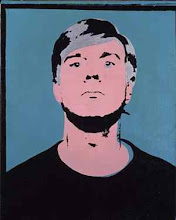 |
| Ori Gersht, Chasing Good Fortune: Against the Tide, Isolated, 2010 |
This Storm is What We Call Progress is an exhibition of work by Ori Gersht at the Imperial War Museum London.
The exhibition title is a quotation from an essay by Walter Benjamin, written in 1940, and his last finished work before his suicide in that year, in which he refers to a painting, once owned by him:
A Klee painting named “Angelus Novus” shows an angel looking as though he is about to move away from something he is fixedly contemplating. His eyes are staring, his mouth is open, his wings are spread. This is how one pictures the angel of history. His face is turned toward the past. Where we perceive a chain of events, he sees one single catastrophe which keeps piling wreckage upon wreckage and hurls it in front of his feet. The angel would like to stay, awaken the dead, and make whole what has been smashed. But a storm is blowing from Paradise; it has got caught in his wings with such violence that the angel can no longer close them. The storm irresistibly propels him into the future to which his back is turned, while the pile of debris before him grows skyward. This storm is what we call progress.Walter Benjamin (1968) Illuminations: Essays and Reflections; ed. by Hannah Arendt, New York: Schocken Books, p257-8
 |
| Paul Klee, Angelus Novus, 1920 |
Gersht's two-screen film Evaders (2009) relates to Benjamin's final and fateful journey following the 'Lister Route' across the Pyrenees, from France to Spain, in an effort to escape from the Nazis and to make his way to America. In Portbou, Spain, he found the border closed and chose to take his own life. One screen shows a figure walking towards the camera, evidently in some pain, the other shows a distant figure disappearing into the landscape.
 |
| Ori Gersht, still from Evaders, 2009 |
The exhibition also features Will You Dance For Me? (2011), another two-screen film, in which an 85-year-old dancer, Yehudit Arnon, rocks back and forth in a chair, slowly recounting her experiences as a young woman in Auschwitz. Her punishment for refusing to dance at an SS officer’s party was to stand, all night, barefoot in the snow, and she pledged that if she survived she would dedicate her life to dance.
 |
| Ori Gersht, still from Will You Dance For Me?, 2011 |
Chasing Good Fortune (2010) explores the symbolism of cherry blossom, in a series of nightime photographs made in Hiroshima, the grounds of the Imperial Palace in Tokyo, and other sites in Japan.
 |
| Ori Gersht, Chasing Good Fortune: Imperial Memories, Night Fly 1, Tokyo, Japan, 2010 |
Although not included in the current show, Gersht's earlier film Pomegranate (2006) deserves a mention. Gersht replicated one of the strange still life compositions by the C17 Spanish painter Juan Sánchez Cotán featuring a suspended pomegranate. The stillness of the scene is disturbed by a soundless bullet entering from one side and spectacularly puncturing the fruit!
 |
Ori Gersht, Pomegranate, 2006 (video still) |
 |
Juan Sánchez Cotán, Quince, Cabbage, Melon and Cucumber, 1602 |
Watch a film of Gersht talking about his work, here, and see Mummery + Schnell for an archive of selected workby Gersht; read a review in the BJP. The exhibition at the Imperial War Museum continues until 29 April.


No comments:
Post a Comment